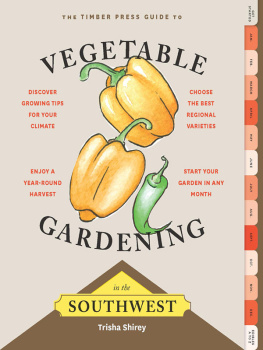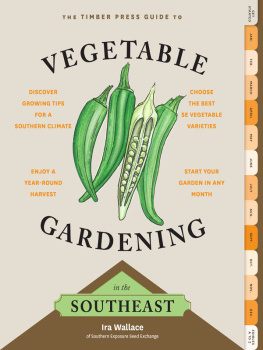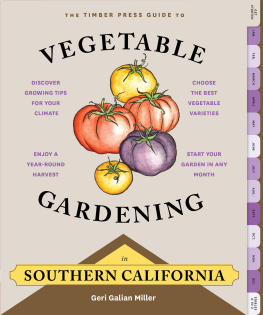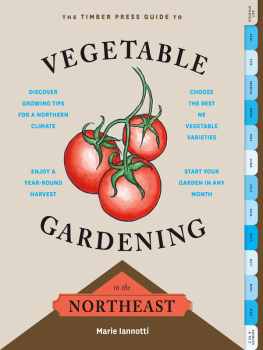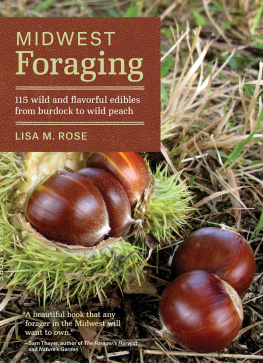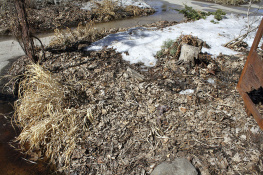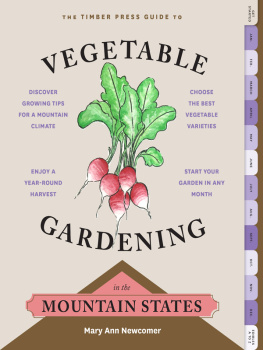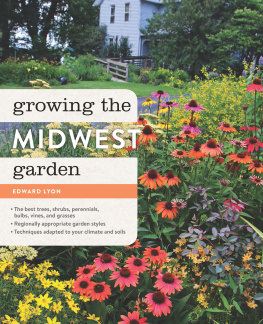THE TIMBER PRESS GUIDE TO VEGETABLE GARDENING
in the
MIDWEST
MICHAEL VANDERBRUG
Timber Press
Portland, Oregon
To my family: Mom, Dad, Jackie, Renee, and my children, Zoe and Pieter, for their persistent faith, patience, and love.
Copyright 2015 by Michael VanderBrug.
All rights reserved.
Chapter-opening illustrations and illustration on page 71 and map on page 12 by Julianna Johnson.
All other illustrations Julia Sadler.
Published in 2015 by Timber Press, Inc.
The Haseltine Building
133 S.W. Second Avenue, Suite 450
Portland, Oregon 97204-3527
timberpress.com
Book design by Kate Giambrone and Julianna Johnson
Cover design by Bree Goodrow
Library of Congress Cataloging-in-Publication Data
VanderBrug, Michael, author.
The Timber Press guide to vegetable gardening in the Midwest/Michael VanderBrug.First edition.
pages cm
Other title: Guide to vegetable gardening in the Midwest
Includes index.
ISBN 978-1-60469-756-8
1. Vegetable gardeningMiddle West. I. Title. II. Title: Guide to vegetable gardening in the Midwest.
SB321.V36 2016
635.0977dc23
2015010367
TABLE OF
CONTENTS
Preface
By gardening in the Midwestland of vast plains, rolling hills, rivers, and lakesyou are participating in a long and complex agricultural history. This regions fertile soils make it second only to California in terms of the diversity of plants that you can grow. Cool-season crops such as lettuce, peas, asparagus, potatoes, and cauliflower flourish in our chilly, damp springs. With the long, hot summers in most areas, beans, tomatoes, eggplant, corn, and other warm-season crops are possible. In fact, you can grow virtually any vegetable, from arugula to zucchini. Even winter, tough as it may be, is a boon to the gardener. The cold temperatures have a sanitizing effect on our gardens, helping to minimize the inevitable pests and diseases. And it gives us some time to reflect, regroup, and start planning for an even better season next year. This is the good news.
Gardening in the Midwest has its challenges too, in the form of harsh winters, summer droughts, unpredictable storms, and weeds, which love our rich soils as much as the vegetables do. This book will show you how to mitigate many challenges through preparation and patience. Of course, sometimes there is nothing to do when a windstorm blows down your tomato trellis, or a torrential downpour floods the entire garden. But for me, this is part of the excitement. Time outside of our normal routinesand just plain outsideexposes us to the elements and heightens awareness of our surroundings. Although the seasons are relatively predictable, what happens within each one is not. On more than one occasion I have harvested crops in a hailstorm, transplanted in mud, and pulled leeks out of frozen soil.
Gardening requires dedicated observation as every year brings new trials, surprises, and successes.
I grew up in New England and now reside in lower west Michigan, roughly the middle of the Midwest region, on what was once my grandfathers farm. I often consider the fact that both places I have lived are on the same latitude, meaning the seasons I experienced as a child are similar to what I experience now, if you substitute tornado warnings for hurricanes and add lake-effect snow to regular snowstorms. It might be the same latitude, but the Midwest is full of unique microclimates, each with its own peculiarities.
As I thought about the word latitude, I considered how it applies to gardening. One definition of latitude is to be given the space to act and decide for oneself. The word is not only used to describe the distance of those imaginary lines from the equator, it also describes the freedom we have in making choices, and the leeway that exists within those choices. This is one of the great joys of gardening. It is your space, and you can decide what you want to grow, how big the garden is, or if you feel like weeding today or not. No garden is perfect, but the one you create is all yours. Over time you will get to know your specific growing area and soil, and slowly become the expert on your garden space like no one else ever could be. Use this book as a guide, and then observe, experiment, taste, and dig in. Above all, savor the spicy arugula, the sun-warmed heirloom tomatoes, the colorfully patterned beans, and the pure joy of digging up perfect fingerling potatoes. You are in the Midwest, and you can grow just about anything!
Acknowledgments
One does not learn and grow in a bubble. I am indebted to all the farmers and gardeners that have come before me for taking risks and making mistakes so I didnt have to. I am thankful for the farmland my grandfather turned over to me and especially the wisdom and knowledge he passed on. I am full of gratitude for the community that has surrounded this farm from the beginning, and for the labor put in by family, friends, interns, and employees. Thank you.

GET STARTED


WELCOME TO THE MIDWEST
The heart of it all. Yes, this nickname belongs to Ohio, but it is also a fitting description of the Midwest region as a whole, the geographic core of our country. The Midwest comprises twelve states: Illinois, Indiana, Iowa, Kansas, Michigan, Minnesota, Missouri, Nebraska, North and South Dakota, Ohio, and Wisconsin. The region is relatively far from the temperature-moderating effect of the oceans, so we can all agree that winters are typically cold and summers are hot and humid. But within those basic parameters, a broad spectrum of growing circumstances awaits due to large-scale microclimates (topography, bodies of water, urban versus rural areas) and those on the small scale in your yard. In order to begin planning, it is important to first understand where your garden fits in our vast regions overall climate, and narrow it down from there.
Understanding Our Climate
As gardeners, we are subject not only to weather but also climate. Where we live informs what we can grow and for how long. To assess how your climate will affect your growing season, this book uses the plant hardiness zone map from the United States Department of Agriculture (USDA). The map is based on average annual minimum winter temperatures and each zone represents a difference of 10 degrees F. The map was originally published in 1960 and was most recently updated in 2012, using more detailed data from the previous 30 years. The Midwest region includes USDA climate zones 3 to 7, which is a rather broad spectrum of growing circumstances.
In addition to knowing your climate zone, crucial knowledge for any gardener is the length of the growing season, or when you can expect the seasons first and last frosts. First frost is when the first frost arrives in fall and knocks out the tomatoes and basil, whereas last frost is the date in spring after which you can begin to plant tender heat-loving crops like eggplants. The crops you grow will require different amounts of days to mature to a useful size. There is nothing worse than bearing witness to a beautiful Brussels sprout stalk that hasnt had enough time to actually form the sprouts. Knowing how long your season is will motivate you to plant on time. This information will also help you decide what varieties to choose or if you should simply skip some crops. Remember that hardiness zones are based on averages, so in cases of extreme cold or heat prepare to assist your plants. As a gardener you will pay closer attention to forecasts than non-gardeners. It is particularly critical to pay attention at the beginning and end of the season and have your emergency plans in place, such as row covers or old sheets for frost protection or a sprinkler to cool off sweltering crops.
Next page

